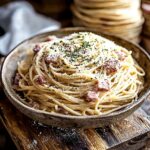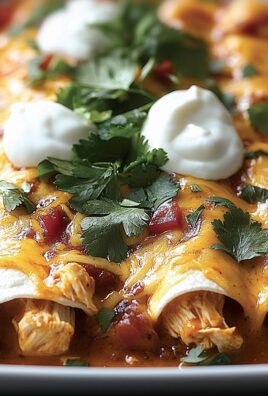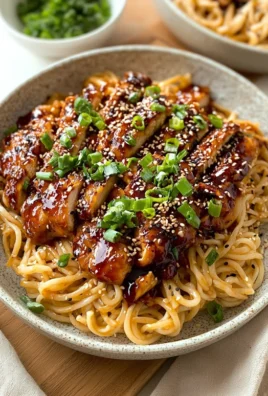Spaghetti Carbonara: just the name conjures up images of creamy, decadent pasta, doesn’t it? Forget complicated sauces and hours in the kitchen; this iconic Italian dish is surprisingly simple to make, yet delivers a flavor explosion that will have you craving more. Have you ever wondered how such a humble collection of ingredients could create such a culinary masterpiece?
While the exact origins of Spaghetti Carbonara are debated, many believe it emerged in Rome during or shortly after World War II. Some theories suggest it was created to satisfy the appetites of American soldiers, using readily available ingredients like bacon and eggs. Others link it to the charcoal makers (“carbonari” in Italian) who needed a hearty and quick meal. Regardless of its true beginnings, Carbonara has become a beloved staple of Italian cuisine and a favorite worldwide.
What makes Spaghetti Carbonara so irresistible? It’s the perfect balance of rich, savory, and comforting flavors. The creamy sauce, made from eggs, Pecorino Romano cheese, and guanciale (or pancetta), clings perfectly to the al dente spaghetti. The crispy, salty pork adds a delightful textural contrast, while a generous sprinkle of black pepper provides a subtle kick. It’s quick, easy, and satisfying a true weeknight winner that feels like a special occasion. Let’s dive in and learn how to make authentic Spaghetti Carbonara that will impress your family and friends!
Ingredients:
- 1 pound spaghetti
- 6 ounces guanciale or pancetta, diced
- 4 large eggs
- 1 cup grated Pecorino Romano cheese, plus more for serving
- 1/2 cup grated Parmesan cheese
- Freshly ground black pepper, to taste
- 2 cloves garlic, minced (optional, but I love it!)
- 2 tablespoons olive oil (if not using guanciale)
- Salt, for pasta water
Preparing the Guanciale (or Pancetta):
Okay, let’s start with the star of the show the guanciale (or pancetta). If you can find guanciale, definitely go for it! It has a richer, more intense flavor than pancetta. But pancetta works perfectly fine too. The key is to get it diced into small, bite-sized pieces.
- If you’re using guanciale, you probably won’t need any extra oil. Guanciale is fatty enough that it will render plenty of its own deliciousness. If you’re using pancetta, drizzle about 2 tablespoons of olive oil into a large skillet or pan.
- Place the diced guanciale (or pancetta) in the cold skillet. This is important! Starting with a cold pan allows the fat to render slowly and evenly, resulting in crispy, flavorful bits.
- Turn the heat to medium. Cook the guanciale (or pancetta), stirring occasionally, until it’s crispy and golden brown. This usually takes about 8-10 minutes. Be patient! Don’t rush it. You want that crispy texture and rendered fat.
- Once the guanciale (or pancetta) is crispy, remove it from the pan with a slotted spoon and set it aside on a plate lined with paper towels to drain. Reserve the rendered fat in the pan this is liquid gold!
- If you’re using garlic, now’s the time to add it to the rendered fat in the pan. Cook the minced garlic over medium-low heat for about 30 seconds, or until fragrant. Be careful not to burn it! Burnt garlic is bitter and will ruin the flavor of your carbonara.
- Turn off the heat and set the pan aside. We’ll need it later.
Preparing the Cheese and Egg Mixture:
While the guanciale (or pancetta) is cooking, let’s get the cheese and egg mixture ready. This is the sauce for our carbonara, so it’s crucial to get it right.
- In a medium bowl, whisk together the eggs, Pecorino Romano cheese, and Parmesan cheese. Make sure everything is well combined.
- Season generously with freshly ground black pepper. Don’t be shy! Carbonara needs a good amount of pepper. I usually use about 1-2 teaspoons, but adjust to your taste.
- Set the bowl aside. We’ll add a little pasta water to this mixture later to create a creamy, emulsified sauce.
Cooking the Spaghetti:
Now, let’s cook the spaghetti. This is pretty straightforward, but there are a few key things to keep in mind.
- Bring a large pot of water to a rolling boil. Make sure you use enough water at least 6 quarts for a pound of spaghetti.
- Once the water is boiling, add a generous amount of salt. I usually use about 2 tablespoons. The water should taste like the sea! Salting the pasta water seasons the pasta from the inside out.
- Add the spaghetti to the boiling water and cook according to the package directions, until al dente. Al dente means “to the tooth” in Italian the pasta should be firm to the bite, not mushy.
- About 1-2 minutes before the pasta is done, reserve about 1 cup of the pasta water. This starchy water is essential for creating a creamy, emulsified sauce.
- Drain the spaghetti immediately, but do not rinse it! We want that starchy coating to help the sauce cling to the pasta.
Assembling the Carbonara:
This is where the magic happens! We’re going to combine all the elements to create our delicious carbonara.
- Immediately add the drained spaghetti to the pan with the rendered guanciale (or pancetta) fat and garlic (if using). Toss the pasta to coat it evenly with the fat.
- Remove the pan from the heat. This is important! If the pan is too hot, the eggs will scramble.
- Pour the cheese and egg mixture over the spaghetti. Toss quickly and continuously to coat the pasta evenly. The residual heat from the pasta will gently cook the eggs and melt the cheese, creating a creamy sauce.
- If the sauce is too thick, add a little of the reserved pasta water, one tablespoon at a time, until it reaches your desired consistency. You want a sauce that coats the pasta without being too watery or too thick.
- Add the crispy guanciale (or pancetta) to the pasta and toss to combine.
- Taste and adjust seasoning as needed. You may need to add a little more salt or pepper.
Serving the Carbonara:
Now for the best part eating! Serve the carbonara immediately, while it’s still hot and creamy.
- Divide the carbonara among individual serving bowls.
- Garnish with extra grated Pecorino Romano cheese and freshly ground black pepper.
- Serve immediately and enjoy! Carbonara is best eaten fresh.
Tips and Tricks for Perfect Carbonara:
- Use high-quality ingredients: The better the ingredients, the better the carbonara. Splurge on good guanciale or pancetta, Pecorino Romano cheese, and fresh eggs.
- Don’t overcook the pasta: Al dente is key! Overcooked pasta will be mushy and won’t hold the sauce well.
- Reserve enough pasta water: The starchy pasta water is essential for creating a creamy, emulsified sauce. Don’t be afraid to use it!
- Work quickly: Carbonara is best when served immediately. The longer it sits, the thicker the sauce will become.
- Don’t add cream! Authentic carbonara does not contain cream. The creaminess comes from the eggs, cheese, and pasta water.
- Experiment with flavors: While traditional carbonara is simple, you can experiment with adding other ingredients, such as mushrooms, peas, or asparagus. Just be sure not to stray too far from the original recipe.
Variations:
While I love a classic carbonara, sometimes it’s fun to mix things up a bit. Here are a few variations you can try:
- Smoked Salmon Carbonara: Substitute the guanciale or pancetta with smoked salmon for a smoky, flavorful twist.
- Vegetarian Carbonara: Omit the guanciale or pancetta and add sautéed mushrooms, asparagus, or peas for a vegetarian-friendly version.
- Spicy Carbonara: Add a pinch of red pepper flakes to the cheese and egg mixture for a little heat.
- Lemon Carbonara: Add a tablespoon of lemon zest to the cheese and egg mixture for a bright, citrusy flavor.
I hope you enjoy this recipe for Spaghetti Carbonara! It’s a classic dish that’s sure to impress. Don’t be intimidated by the simplicity of the ingredients the key is to use high-quality ingredients and follow the instructions carefully. Buon appetito!

Conclusion:
So there you have it! This isn’t just another pasta dish; it’s a journey to Italy in a bowl. The creamy, rich sauce clinging to perfectly cooked spaghetti, the salty pancetta, and the sharp bite of Pecorino Romano it’s a symphony of flavors that will leave you craving more. I truly believe this Spaghetti Carbonara recipe is a must-try for anyone who appreciates simple ingredients transformed into something extraordinary. It’s quick enough for a weeknight dinner but elegant enough to impress guests at a weekend gathering. But why is this recipe so special? It’s all about the technique. Mastering the art of emulsifying the egg yolks with the pasta water is key to achieving that signature creamy texture without using any cream. It’s a delicate balance, but once you get the hang of it, you’ll be making restaurant-quality carbonara in your own kitchen. And trust me, the satisfaction of creating something so delicious from scratch is incredibly rewarding.Serving Suggestions and Variations:
Now, let’s talk about how you can make this dish your own! While the classic recipe is perfect as is, there are plenty of ways to customize it to your liking. * Spice it up: Add a pinch of red pepper flakes to the sauce for a little heat. * Vegetarian option: Substitute the pancetta with sautéed mushrooms or zucchini for a meat-free version. You can even add a touch of smoked paprika to mimic the smoky flavor of the pancetta. * Add some greens: Toss in some fresh spinach or arugula at the end for a boost of nutrients and a pop of color. * Elevate the presentation: Serve the carbonara in warmed bowls and garnish with freshly cracked black pepper and a sprinkle of extra Pecorino Romano. A drizzle of high-quality olive oil never hurts either! * Wine Pairing: A crisp, dry white wine like Pinot Grigio or Sauvignon Blanc pairs beautifully with the richness of the carbonara. For a heartier meal, consider serving it with a side of garlic bread or a simple green salad. And if you happen to have any leftovers (though I doubt you will!), they’re delicious reheated the next day. Just add a splash of milk or cream while reheating to prevent the sauce from drying out. I’m so excited for you to try this recipe! It’s a dish that I make regularly, and it always brings a smile to my face. It’s comforting, satisfying, and incredibly flavorful. I’ve shared it with countless friends and family members, and it’s always a hit. So, what are you waiting for? Gather your ingredients, put on some Italian music, and get cooking! I promise you won’t be disappointed. And most importantly, don’t be afraid to experiment and make it your own. Cooking should be fun and creative, so let your imagination run wild! Once you’ve made it, I would absolutely love to hear about your experience. Did you make any variations? What did you think of the flavor? Share your photos and stories in the comments below! I can’t wait to see your creations and hear your feedback. Happy cooking, and Buon Appetito! Remember, mastering this Spaghetti Carbonara recipe will make you a star in your kitchen! Print
Spaghetti Carbonara: The Ultimate Guide to Authentic Italian Recipe
- Total Time: 35 minutes
- Yield: 4–6 servings 1x
Description
Rich and creamy Italian pasta with guanciale (or pancetta), eggs, Pecorino Romano cheese, and black pepper. Simple ingredients, incredible flavor!
Ingredients
- 1 pound spaghetti
- 6 ounces guanciale or pancetta, diced
- 4 large eggs
- 1 cup grated Pecorino Romano cheese, plus more for serving
- 1/2 cup grated Parmesan cheese
- Freshly ground black pepper, to taste
- 2 cloves garlic, minced (optional)
- 2 tablespoons olive oil (if using pancetta)
- Salt, for pasta water
Instructions
- Prepare Guanciale/Pancetta: If using guanciale, no oil is needed. For pancetta, drizzle 2 tablespoons olive oil into a large skillet. Place diced guanciale/pancetta in the cold skillet. Cook over medium heat, stirring occasionally, until crispy and golden brown (8-10 minutes). Remove with a slotted spoon and set aside on paper towels, reserving the rendered fat in the pan. If using garlic, add it to the rendered fat and cook over medium-low heat for 30 seconds, or until fragrant. Turn off the heat.
- Prepare Cheese and Egg Mixture: In a medium bowl, whisk together eggs, Pecorino Romano cheese, and Parmesan cheese. Season generously with freshly ground black pepper (1-2 teaspoons, or to taste). Set aside.
- Cook Spaghetti: Bring a large pot of water to a rolling boil. Add a generous amount of salt (about 2 tablespoons). Add spaghetti and cook according to package directions until al dente. Reserve 1 cup of pasta water 1-2 minutes before draining. Drain the spaghetti immediately, do not rinse.
- Assemble Carbonara: Immediately add the drained spaghetti to the pan with the rendered guanciale/pancetta fat and garlic (if using). Toss to coat. Remove the pan from the heat. Pour the cheese and egg mixture over the spaghetti. Toss quickly and continuously to coat the pasta evenly. If the sauce is too thick, add reserved pasta water, one tablespoon at a time, until desired consistency is reached. Add the crispy guanciale/pancetta to the pasta and toss to combine.
- Serve: Taste and adjust seasoning as needed. Divide the carbonara among individual serving bowls. Garnish with extra grated Pecorino Romano cheese and freshly ground black pepper. Serve immediately.
Notes
- Use high-quality ingredients for the best flavor.
- Don’t overcook the pasta; al dente is key.
- Reserve enough pasta water; it’s essential for a creamy sauce.
- Work quickly to prevent the sauce from becoming too thick.
- Authentic carbonara does not contain cream.
- Experiment with flavors by adding mushrooms, peas, or asparagus.
- Prep Time: 15 minutes
- Cook Time: 20 minutes






Leave a Comment